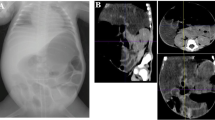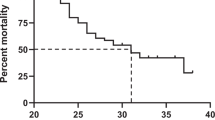Abstract
Background
Premature infants treated with laparostomy in the first days of their life represent a group of complex patients with high morbidity and mortality rates. Laparostomy is a surgical treatment method in which the peritoneal cavity is opened anteriorly and deliberately left open, hence often called “open abdomen”. The aim of this study was to analyze crucial factors influencing the postoperative outcome of premature infants treated this way.
Methods
Between March 2002 and August 2012, we treated 40 premature infants with a median gestational age of 29 weeks (range from 24 to 34 weeks) with open abdomen in our institution. Their data were analyzed retrospectively. They were divided into two groups depending on in-hospital survival.
Results
Indications for surgery were ileus (n = 16), spontaneous intestinal perforation (n = 11), gastroschisis (n = 8) and necrotizing enterocolitis (NEC, n = 5). The overall in-hospital mortality was 43 % (17 of 40 patients). Postoperative anemia was the only significant factor influencing mortality rates in our patients (10 vs. 14 patients; p = 0.028). Neither the indication of surgery, nor week of gestation, nor birth weight had any significant influence on postoperative survival. Twenty-one of the 23 surviving patients reached fascia closure.
Conclusions
In our study, outcome of premature infants with open abdomen in the first days of their life seems to depend more on an operation and a postoperative course without complications than on the preoperative conditions of the children. Postoperative anemia seems to be a significant negative prognostic marker. Patients reaching fascia closure mainly survive.

Similar content being viewed by others
Explore related subjects
Discover the latest articles and news from researchers in related subjects, suggested using machine learning.References
Blakely ML, Lally KP, McDonald S, Brown RL, Barnhart DC, Ricketts RR, Thompson WR, Scherer LR, Klein MD, Letton RW, Chwals WJ, Touloukian RJ, Kurkchubasche AG, Skinner MA, Moss RL, Hilfiker ML (2005) Postoperative outcomes of extremely low birth-weight infants with necrotizing enterocolitis or isolated intestinal perforation: a prospective cohort study by the NICHD Neonatal Research Network. Ann Surg 241:984–989
de Souza JC, da Motta UI, Ketzer CR (2001) Prognostic factors of mortality in newborns with necrotizing enterocolitis submitted to exploratory laparotomy. J Pediatr Surg 36:482–486
Ricketts RR, Jerles ML (1990) Neonatal necrotizing enterocolitis: experience with 100 consecutive surgical patients. World J Surg 14:600–605
Holman RC, Stoll BJ, Clarke MJ, Glass RI (1997) The epidemiology of necrotizing enterocolitis infant mortality in the United States. Am J Public Health 87:2026–2031
Uauy RD, Fanaroff AA, Korones SB, Phillips EA, Phillips JB, Wright LL (1991) Necrotizing enterocolitis in very low birth weight infants: biodemographic and clinical correlates. National Institute of Child Health and Human Development Neonatal Research Network. J Pediatr 119:630–638
Blakely ML, Tyson JE, Lally KP, McDonald S, Stoll BJ, Stevenson DK, Poole WK, Jobe AH, Wright LL, Higgins RD (2006) Laparotomy versus peritoneal drainage for necrotizing enterocolitis or isolated intestinal perforation in extremely low birth weight infants: outcomes through 18 months adjusted age. Pediatrics 117:e680–e687
Ahmed T, Ein S, Moore A (1998) The role of peritoneal drains in treatment of perforated necrotizing enterocolitis: recommendations from recent experience. J Pediatr Surg 33:1468–1470
Moss RL, Dimmitt RA, Barnhart DC, Sylvester KG, Brown RL, Powell DM, Islam S, Langer JC, Sato TT, Brandt ML, Lee H, Blakely ML, Lazar EL, Hirschl RB, Kenney BD, Hackam DJ, Zelterman D, Silverman BL (2006) Laparotomy versus peritoneal drainage for necrotizing enterocolitis and perforation. N Engl J Med 354:2225–2234
Rao SC, Basani L, Simmer K, Samnakay N, Deshpande G (2011) Peritoneal drainage versus laparotomy as initial surgical treatment for perforated necrotizing enterocolitis or spontaneous intestinal perforation in preterm low birth weight infants. Cochrane Database Syst Rev p CD006182
Chandler JC, Hebra A (2000) Necrotizing enterocolitis in infants with very low birth weight. Semin Pediatr Surg 9:63–72
Dominguez KM, Moss RL (2012) Necrotizing enterocolitis. Clin Perinatol 39:387–401
Argumosa SY, Fernandez CMS, Gonzalvez PJ, Hernandez AE, Baquero CM, Medina MC, Rubio RA, Martinez GA (2011) Necrotizing entercolitis and intestinal perforation in very low weight premature infants: which is the best surgical option? Cir Pediatr 24:142–145
Bysiek A, Palka J, Pietrzyk JJ, Mitkowska Z, Tomasik T (2002) Peritoneal drainage as an alternative to laparotomy in premature infants with complicated necrotizing enterocolitis. Przegl Lek 59(Suppl 1):67–69
Sola JE, Tepas JJ III, Koniaris LG (2010) Peritoneal drainage versus laparotomy for necrotizing enterocolitis and intestinal perforation: a meta-analysis. J Surg Res 161:95–100
Blakely ML, Gupta H, Lally KP (2008) Surgical management of necrotizing enterocolitis and isolated intestinal perforation in premature neonates. Semin Perinatol 32:122–126
Guner YS, Friedlich P, Wee CP, Dorey F, Camerini V, Upperman JS (2009) State-based analysis of necrotizing enterocolitis outcomes. J Surg Res 157:21–29
Luig M, Lui K (2005) Epidemiology of necrotizing enterocolitis—Part II: risks and susceptibility of premature infants during the surfactant era: a regional study. J Paediatr Child Health 41:174–179
Luig M, Lui K (2005) Epidemiology of necrotizing enterocolitis—Part I: changing regional trends in extremely preterm infants over 14 years. J Paediatr Child Health 41:169–173
Fitzgibbons SC, Ching Y, Yu D, Carpenter J, Kenny M, Weldon C, Lillehei C, Valim C, Horbar JD, Jaksic T (2009) Mortality of necrotizing enterocolitis expressed by birth weight categories. J Pediatr Surg 44:1072–1075
Guelfand M, Santos M, Olivos M, Ovalle A (2012) Primary anastomosis in necrotizing enterocolitis: the first option to consider. Pediatr Surg Int 28:673–676
Hall NJ, Curry J, Drake DP, Spitz L, Kiely EM, Pierro A (2005) Resection and primary anastomosis is a valid surgical option for infants with necrotizing enterocolitis who weigh less than 1000 g. Arch Surg 140:1149–1151
Ade-Ajayi N, Kiely E, Drake D, Wheeler R, Spitz L (1996) Resection and primary anastomosis in necrotizing enterocolitis. J R Soc Med 89:385–388
Pierro A (2005) The surgical management of necrotising enterocolitis. Early Hum Dev 81:79–85
Yasmeen BH, Chowdhury MA, Hoque MM, Hossain MM, Jahan R, Akhtar S (2012) Effect of short-term recombinant human erythropoietin therapy in the prevention of anemia of prematurity in very low birth weight neonates. Bangladesh Med Res Counc Bull 38:119–123
Soubasi V, Kremenopoulos G, Diamanti E, Tsantali C, Sarafidis K, Tsakiris D (1995) Follow-up of very low birth weight infants after erythropoietin treatment to prevent anemia of prematurity. J Pediatr 127:291–297
Saager L, Turan A, Reynolds LF, Dalton JE, Mascha EJ, Kurz A (2013) The association between preoperative anemia and 30-day mortality and morbidity in noncardiac surgical patients. Anesth Analg 117:909–915
Beattie WS, Karkouti K, Wijeysundera DN, Tait G (2009) Risk associated with preoperative anemia in noncardiac surgery: a single-center cohort study. Anesthesiology 110:574–581
Conflict of interest
All authors declare that they have no conflict of interest.
Author information
Authors and Affiliations
Corresponding author
Rights and permissions
About this article
Cite this article
Lambertz, A., Binnebösel, M., Röth, A. et al. Postoperative outcome in premature infants with open abdomen. Hernia 18, 351–356 (2014). https://doi.org/10.1007/s10029-014-1226-8
Received:
Accepted:
Published:
Issue Date:
DOI: https://doi.org/10.1007/s10029-014-1226-8




